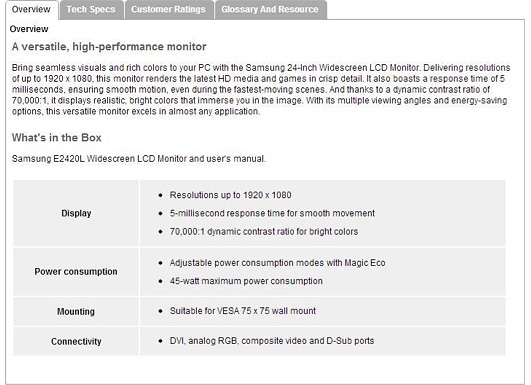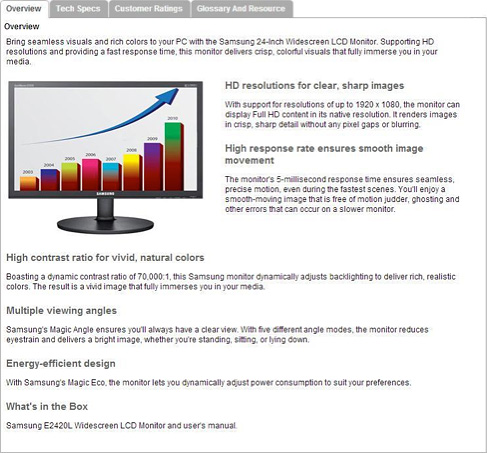While manufacturers continue to rely on Mad Men-style agencies to help sell their products to today’s information-hungry and device-savvy consumers, they must invest in much more than catchy jingles and six-figure Super Bowl commercials to succeed. Without comprehensive, user-friendly, and accurate product information on their own websites and retail partner product pages, manufacturers will lose their ability to affect the way consumers make buying decisions.

Counterintuitive though it may seem, most product manufacturers are (still) beholden to a three-step formula to sell their product called “Stick, Drive, Convert.” This formula sums up the olden days of marketing – between 1950 and 1997 – before the Internet as we know it existed, when tablets were what the doctor ordered if you were depressed or bloated. Roughly:
- Stick involves hiring a Mad Man to build brand awareness,
- Drive involves sending consumers to retailers, and
- Convert essentially hopes that the retail experience will be sufficient to inspire purchases.
If you’re of a certain demographic, you’ll recall the stickiness of the “I can’t believe I ate the whole thing” campaign. More recently, “Just Do It” became the mantra of a new generation of athletes. You can probably think of a dozen more off the top of your head.
Before the web, newspapers – particularly Sunday editions – were the primary traffic drivers, offering drawers full of coupons, two-for-one deals, lowest prices of the season, and so forth. As for converting, companies primarily relied on a combination of the retailer’s sales staff and box copy to push products. Heaven forbid a consumer actually had a difficult question about a product!
The stick, drive, convert formula is time-tested; it’s not going away anytime soon. But that doesn’t mean manufacturers’ general approach to it shouldn’t be updated for today’s digital reality.
Conversion, meet convergence
Today, the stick and drive steps have been largely taken over by digital ad agencies, banner ads, YouTube videos, and social media. Conversion, once dependent upon brick-and-mortar stores and compelling box copy, now relies heavily on the digital retail experience and online content. But to reach today’s consumers, product manufacturers must understand the power of convergence and the related “research online, purchase offline” (ROPO) effect.
What do I mean by this? Studies show that more than half of all retail sales are influenced by online content, and that, prior to making significant buying decisions, many consumers visit multiple sites. Add to these trends recent holiday numbers pointing to the massive growth of mobile online purchases and the message is clear: shopping is moving online.
Despite this, the typical, online “box copy” experience feels like an afterthought (unless, of course, it’s a product sold by a major retailer themselves)

A major brand’s product detail page on one of the world’s most popular retail sites.
Spending millions of dollars to drive consumers to a product page that does little more than provide box copy is, as one of my colleagues so eloquently tells our clients, like “investing in a fleet of Cadillacs to drive your customers to a turd.” If the content that consumers are driven to does not inspire confidence, consumers will continue their product search, potentially turning to competing brands.
Although the retailer doesn’t care if this happens – a dollar spent on Nike is the same as a dollar spent on Adidas – manufacturers such as Nike and Adidas certainly do. To take advantage of this digital reality, product manufacturers need to invest in the online product information that consumers want: product-detail content that espouses the benefits of their products in a simple, compelling way.
Empower the consumer
My company, content26, recently partnered with major e-commerce retailer in an A/B test to measure the effects of product-detail content on conversion. We produced enhanced product-detail content for 128 products sold by the retailer. For a period of 60 days, half of the visitors were shown product pages with generic content provided by an aggregator. By “generic” content I mean content sourced from a company that scrapes manufacturer sites for basic product information and then sells that information back to retailers. The other half were shown the “enhanced” product pages we created. We wanted to determine whether or not bespoke pages gave products a measurable advantage.
What did we learn? There was a 38 percent increase in conversion rates among customers who were showed the enhanced content. The thing is, while the stick and drive steps of advertising can require that a manufacturer invest significant time and resources – for planning, conception, and execution – facilitating digital conversion is relatively inexpensive. Each enhanced product page took just a couple of hours to create.
To better understand what I mean by enhanced product detail content, let me walk through a few possible iterations of a retail product page.
Inexpensive but good
As depicted earlier, here is a major brand’s product detail page on one of the world’s most popular retail sites:

At a glance, does this look like a good user experience? Does it provide enough visual and written information for a user to commit to a fairly significant purchase? If you’re uncertain, you might also consider these questions (that are likely going through a user’s head):
- How will a “fast 5 ms response time” benefit me?
- What about a 70,000:1 dynamic contrast ratio?
- What do “narrow bezels” and “sleek necks” mean?
Now take a look at this description:

This is almost unquestionably more user-friendly. A few answers to the above questions are provided, the text is easier to scan, and the uses and benefits are clearly stated. Users also know what’s included in the box, so they aren’t surprised when it arrives at their door.
Finally, take a look at this:

This description, which I consider to be good-not-great, provides information-rich headers that can be quickly scanned, plenty of whitespace to ease the strain of reading, and user benefits for each product feature. This leaves someone with little guesswork as to how this monitor might benefit them.
The product may ultimately not be what a user’s looking for, but an accurate, compelling product description can give users greater confidence to come to their own conclusion. Although the page above won’t win any glamour awards from a design perspective, it does its job by providing the reader with a more informed and thorough reading experience.
Make content a priority
My experience shows that manufacturers who take control of their product pages on retail sites benefit from higher conversion rates (10-35%) than manufacturers that leave the content in the hands of their retailers.
Retailers can contribute to higher conversion rates by providing their consumers with a positive buying experience – smart site designs, competitive price points, and outstanding customer service. They often do not have the resources or skill sets to produce effective product detail content. So while launching a multifaceted advertising and marketing campaign that fires up the creative synapses of the organization – in other words, building the sexy and (hopefully) memorable content – is the dream of every Mad Woman, ignoring the far less-sexy and far less-expensive content at the product-page level undermines that creativity.
In sum, manufacturers should dig deep to get their customers behind the wheel of a sleek new Caddy. They should also make sure to steer their customers clear of the turds.